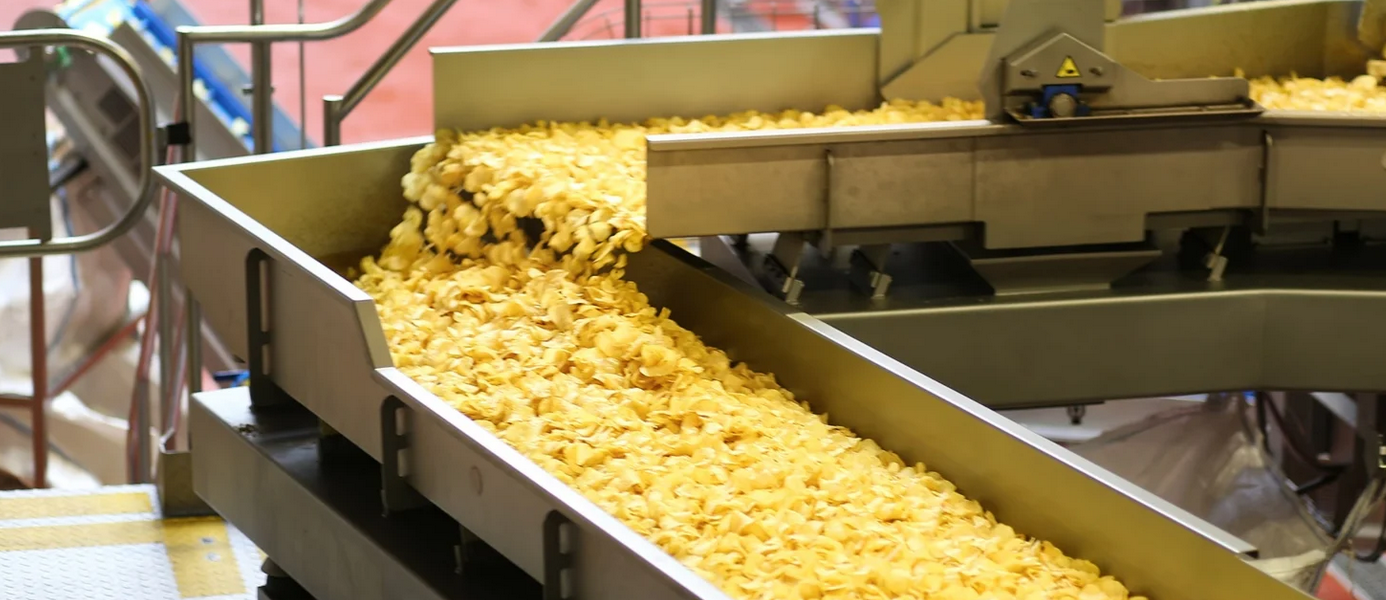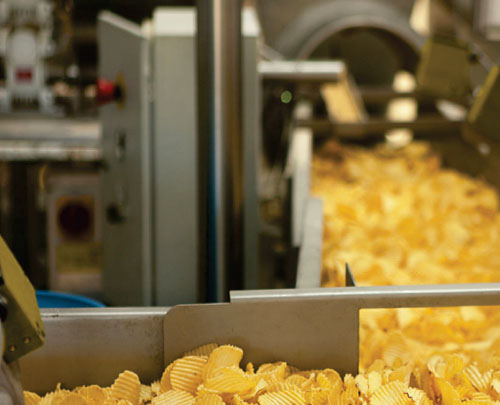In the US, mass production of chips is a multibillion-dollar industry with several major players dominating the market. Advanced machinery and automated processes ensure rapid production, consistent quality, and efficient packaging.

Raw materials, mainly potatoes, undergo washing, peeling, slicing, frying, and seasoning before being packaged for distribution. The continuous demand for diverse flavors and health-conscious options drives innovation, leading to various chip products.
A pressing inquiry is how factories infuse chips with spicy flavors.
How do They Make Spicy Chips in Factories?
Factories add spices to chips by mixing the desired seasonings in large batches according to specific recipes. Then, as the freshly fried chips move on a conveyor belt, they pass through a seasoning drum or tumbler, where the seasoning mix is evenly sprayed or dropped onto them, ensuring a uniform flavor distribution.
However, you need to know that factories have four different types of chip preparation and spice addition.
Factories producing chips (or crisps, depending on the region) meticulously ensure the flavors are consistent, tasty, and appealing to the masses. Let’s dive deep into how these factories add spices to chips,
- Unflavored or Natural Chips:
- Preparation: After potatoes are washed, peeled, and sliced, they’re fried in high-quality oil.
- Flavoring: These chips are not flavored or seasonings after frying. They have only the natural taste of potato, complemented by the oil and a touch of salt.
- Consumer Appeal: As you mentioned, these are especially attractive to health-conscious consumers or those who want an unadulterated potato taste.
- Naturally Colored and Flavored Chips:
- Preparation: Similar initial process as the unflavored chips.
- Flavoring: After frying, natural extracts, herbs, or spices are sprayed or tumbled onto the chips. Examples include paprika for a slight red tint or beetroot powder for a purple hue.
- Consumer Appeal: These chips offer a mid-ground for those who want flavor but wish to avoid artificial additives.
- Naturally Flavored with Artificial Colors:
- Preparation: Again, the starting process resembles the two previous types.
- Flavoring: While natural flavors, extracts, or essential oils are used for the taste profile, artificial colorants give the chips their hue. This combination allows for vibrant colors that are not always achievable with natural colorants.
- Consumer Appeal: These chips can be very visually appealing, making them popular for themed events or marketing campaigns. However, they might not be the first choice for consumers to avoid synthetic additives.
- Specialty Spice Mixes for Gourmet Varieties:
- Preparation: Potatoes may be specially selected or processed to match the premium nature of these chips.
- Flavoring: These chips might be seasoned with unique spices, herbs, and other flavorings blends. Some might even include flavors mimicking popular dishes (like ‘Roast Chicken’ or ‘Barbecue Ribs’). Quality control is stringent, ensuring a consistent flavor profile across batches.
- Consumer Appeal: Often positioned as a premium or gourmet option, these chips cater to a niche market willing to pay a little extra for a unique flavor experience.
General Process of Flavoring:
- Batch Mixing: Spices and flavors are pre-mixed in large batches according to specific recipes.
- Application: Once the chips are fried and any excess oil is drained, they move on a conveyor belt through a seasoning drum or tumbler. The seasoning mix is sprayed or dropped onto the chips as they tumble. The tumbling action ensures an even distribution of the seasoning.
- Quality Control: Random samples are taken from each batch and tested to ensure flavor consistency and adherence to standards.
Specific methodologies can vary between manufacturers and even between different products within the same brand. Each brand might have proprietary methods and secret recipes that differentiate its products from competitors.
Factories utilize various processes to transform raw materials into final products. Among these processes are dehydration, heating, cooling, and transformation. The transformation process can involve modifying starch to enhance its utility in the food sector, shaping mash and shreds into products like croquettes and hash browns, or expanding base ingredients to create snacks.
Each process requires multiple sub-operations, such as washing, cutting, blanching, and packing. To give a sense of the intricacy, from when raw tubers enter the factory to when they leave as packaged products, 66 distinct operations are identified. Breaking it down further, the production of French fries involves approximately 30 operations, whereas the creation of potato flakes needs just 8.
Heat mapping and hierarchical clustering are employed to better understand these operations. This analytical approach identifies two primary categories of operations: physical and mechanical. Physical operations, often characterized by heating and cooling, consume significant energy. On the other hand, mechanical operations, like separation, grading, sorting, and shredding, are less energy-intensive.
Comparing the potato processing industry with the wheat processing industry offers further perspective. In large factories dedicated to potato processing, operations often focus on reducing the moisture content of the product, coupled with prolonged storage at low temperatures. This contrasts with wheat processing, particularly in smaller bakeries, where the number of operations is fewer, and the emphasis is on increasing the moisture content. Wheat-based products, like bread, typically have a shorter shelf life, being stored in ambient conditions for approximately a day.
Extrusion technology to produce spicy chips
Extrusion technology is a standard method used in the food industry, including producing specific chips or snacks.

Here’s how it works in the context of chip preparation:
Extrusion Technology in Chips Preparation:
- Basic Principle: Extrusion involves forcing a raw material mixture through a shaped die (orifice) under high temperature and pressure conditions. The process transforms the mixture into a specific shape and structure dictated by the design of the die.
- Raw Material Preparation: The raw materials, which can include grains, potatoes, or other starchy sources, are first ground into a fine powder. This powder is then mixed with other ingredients, such as flavors, colors, and certain additives, creating a dough-like consistency.
- Feeding: This dough is then fed into the extruder, which undergoes mechanical shearing and heating.
- Extrusion Process: Inside the extruder, especially a screw extruder, the dough is subjected to high pressure and temperature. As it moves forward through the extruder, the pressure and temperature increase. Once the dough reaches the die at the extruder’s end, it’s forced through the openings.
- Expansion: Upon exiting the die, the sudden drop in pressure causes the extruded product to expand rapidly. This expansion creates a light, crispy texture, characteristic of many extruded snacks.
- Cutting and Shaping: The continuous extruded product can be cut into desired lengths or shapes immediately after exiting the extruder.
- Final Processing: The extruded chips might undergo further processes like frying, baking, or flavoring to achieve the desired product.
Extrusion technology is versatile and allows for the production of various shapes and textures, which is not achievable through traditional chip-making methods. This method makes many popular snacks, including specific puffed chips, cereal products, and other shaped snack items.
Spice Mixing Process in Chips Factory
Spice and flavor mixing is crucial to achieving the desired taste profile in the chips factory. Here’s a detailed breakdown of how spiciness is integrated into the chips:
1. Spice Grinding and Compression:
- The initial stage involves grinding the raw spices into fine powders using specialized grinding equipment.
- Once the spices are ground, they are compressed using pneumatic equipment, ensuring the potency and consistency of the spice mix.
2. Automated Mixing:
- The ground and compressed spice powders are then channeled to mixers using pneumatic connections.
- These mixers blend the spice powders according to precise customer requirements.
- This entire process is fully automated, eliminating the need for human intervention and ensuring consistency.
3. Continuous Processing:
- Although the mixing process is done in batches, the overarching system is designed to run non-stop.
- Once the mixing cycle completes, the mixture is emptied into a small hopper.
- The Material is pneumatically transported to an intermediate storage silo or tank.
Post-mixing Operations:
4. Storage:
- The finished spice powders are typically stored in 25 kg bags, jumbo bags, or Intermediate Bulk Containers (IBCs) for efficient storage and ease of integration into consumer packaging.
5. Bagging:
- The choice of an appropriate automatic bagging machine is crucial post-mixing. This ensures that the spice mix is accurately weighed and packaged for consumers.
- The type of product, the packaging material, and the required throughput rate (number of bags filled per minute) are factors determining the choice of bagging machine.
6. Sealing and Dispatch:
- Once filled, the bags are either heat-sealed or stitched, ensuring the spice mix remains uncontaminated and fresh.
- These sealed bags are then ready for dispatch to the next production stage or the market.
- How Many Tablespoons is One Clove of Garlic? - June 26, 2024
- How to Measure 3/4 Cup When You Don’t Have the Right Measuring Cup? - June 6, 2024
- How Much Does Cooked Pasta Weight Compare To Dry? - April 30, 2024
